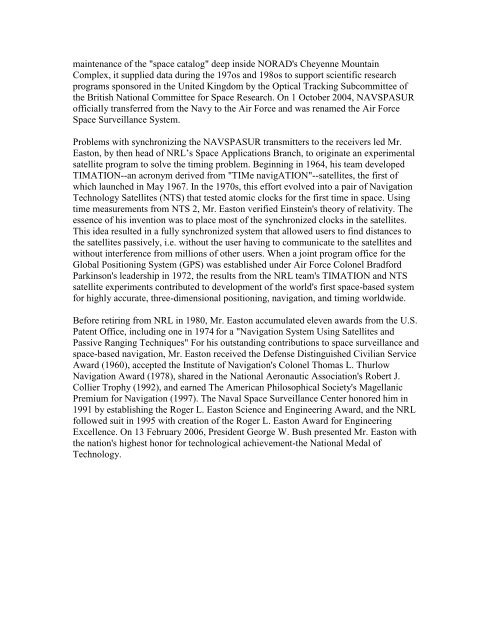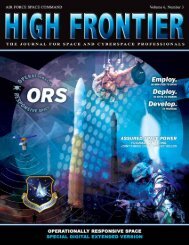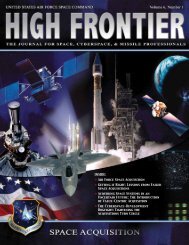Mr. Roger L Easton, Sr. Inducted 2009 Mr. Roger L Easton, Sr., was ...
Mr. Roger L Easton, Sr. Inducted 2009 Mr. Roger L Easton, Sr., was ...
Mr. Roger L Easton, Sr. Inducted 2009 Mr. Roger L Easton, Sr., was ...
Create successful ePaper yourself
Turn your PDF publications into a flip-book with our unique Google optimized e-Paper software.
maintenance of the "space catalog" deep inside NORAD's Cheyenne MountainComplex, it supplied data during the 197os and 198os to support scientific researchprograms sponsored in the United Kingdom by the Optical Tracking Subcommittee ofthe British National Committee for Space Research. On 1 October 2004, NAVSPASURofficially transferred from the Navy to the Air Force and <strong>was</strong> renamed the Air ForceSpace Surveillance System.Problems with synchronizing the NAVSPASUR transmitters to the receivers led <strong>Mr</strong>.<strong>Easton</strong>, by then head of NRL’s Space Applications Branch, to originate an experimentalsatellite program to solve the timing problem. Beginning in 1964, his team developedTIMATION--an acronym derived from "TIMe navigATION"--satellites, the first ofwhich launched in May 1967. In the 1970s, this effort evolved into a pair of NavigationTechnology Satellites (NTS) that tested atomic clocks for the first time in space. Usingtime measurements from NTS 2, <strong>Mr</strong>. <strong>Easton</strong> verified Einstein's theory of relativity. Theessence of his invention <strong>was</strong> to place most of the synchronized clocks in the satellites.This idea resulted in a fully synchronized system that allowed users to find distances tothe satellites passively, i.e. without the user having to communicate to the satellites andwithout interference from millions of other users. When a joint program office for theGlobal Positioning System (GPS) <strong>was</strong> established under Air Force Colonel BradfordParkinson's leadership in 1972, the results from the NRL team's TIMATION and NTSsatellite experiments contributed to development of the world's first space-based systemfor highly accurate, three-dimensional positioning, navigation, and timing worldwide.Before retiring from NRL in 1980, <strong>Mr</strong>. <strong>Easton</strong> accumulated eleven awards from the U.S.Patent Office, including one in 1974 for a "Navigation System Using Satellites andPassive Ranging Techniques" For his outstanding contributions to space surveillance andspace-based navigation, <strong>Mr</strong>. <strong>Easton</strong> received the Defense Distinguished Civilian ServiceAward (1960), accepted the Institute of Navigation's Colonel Thomas L. ThurlowNavigation Award (1978), shared in the National Aeronautic Association's Robert J.Collier Trophy (1992), and earned The American Philosophical Society's MagellanicPremium for Navigation (1997). The Naval Space Surveillance Center honored him in1991 by establishing the <strong>Roger</strong> L. <strong>Easton</strong> Science and Engineering Award, and the NRLfollowed suit in 1995 with creation of the <strong>Roger</strong> L. <strong>Easton</strong> Award for EngineeringExcellence. On 13 February 2006, President George W. Bush presented <strong>Mr</strong>. <strong>Easton</strong> withthe nation's highest honor for technological achievement-the National Medal ofTechnology.











